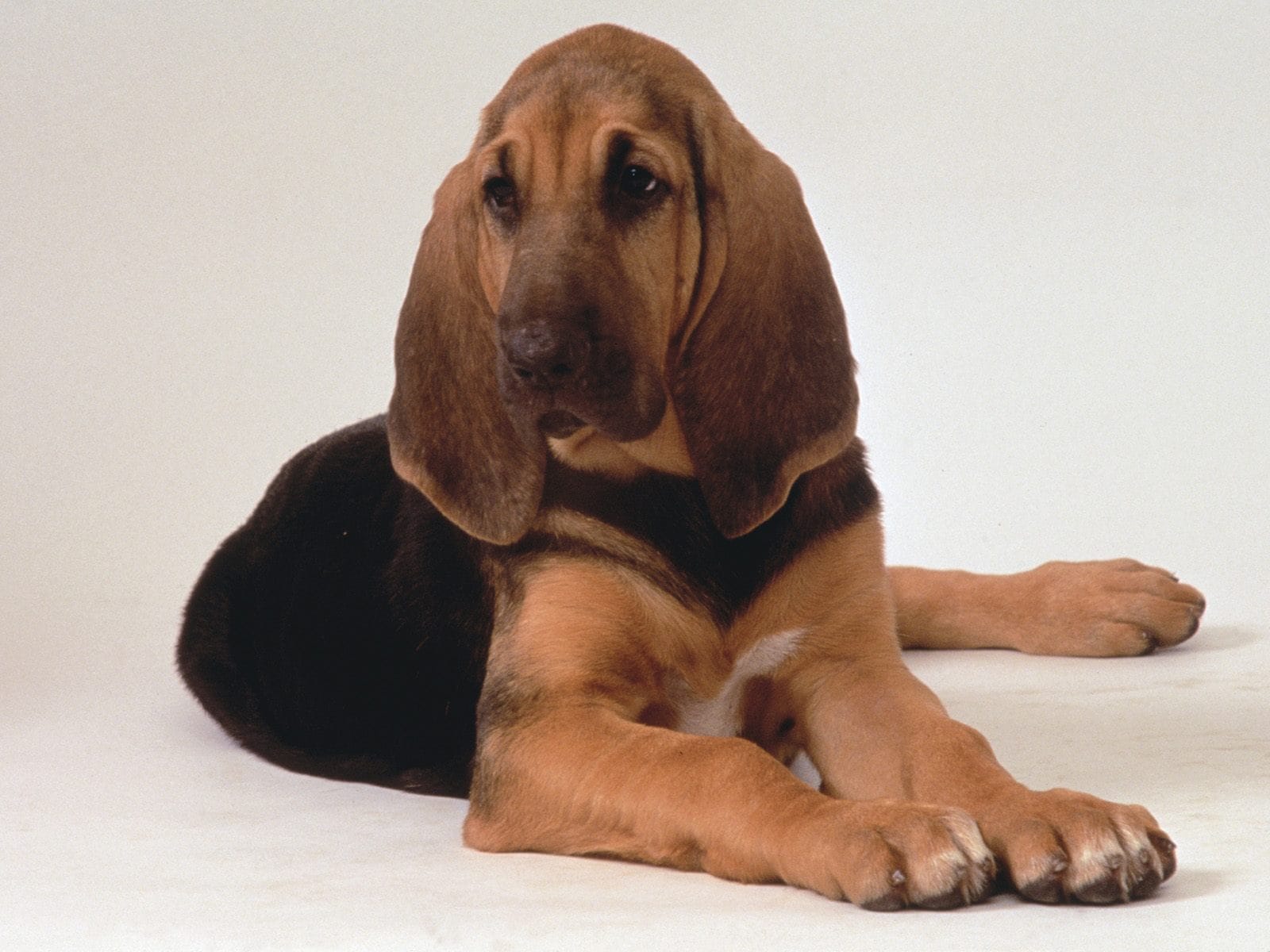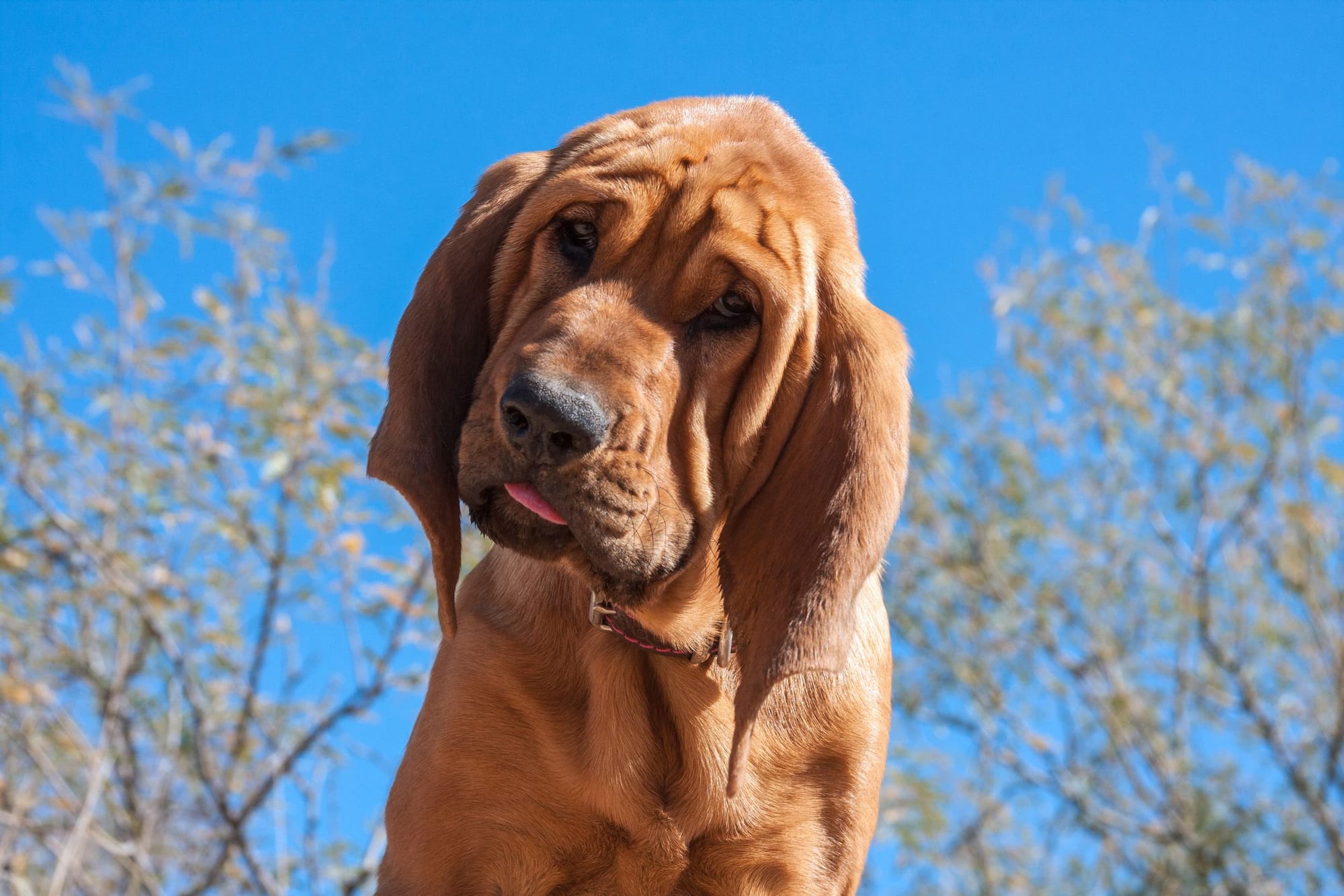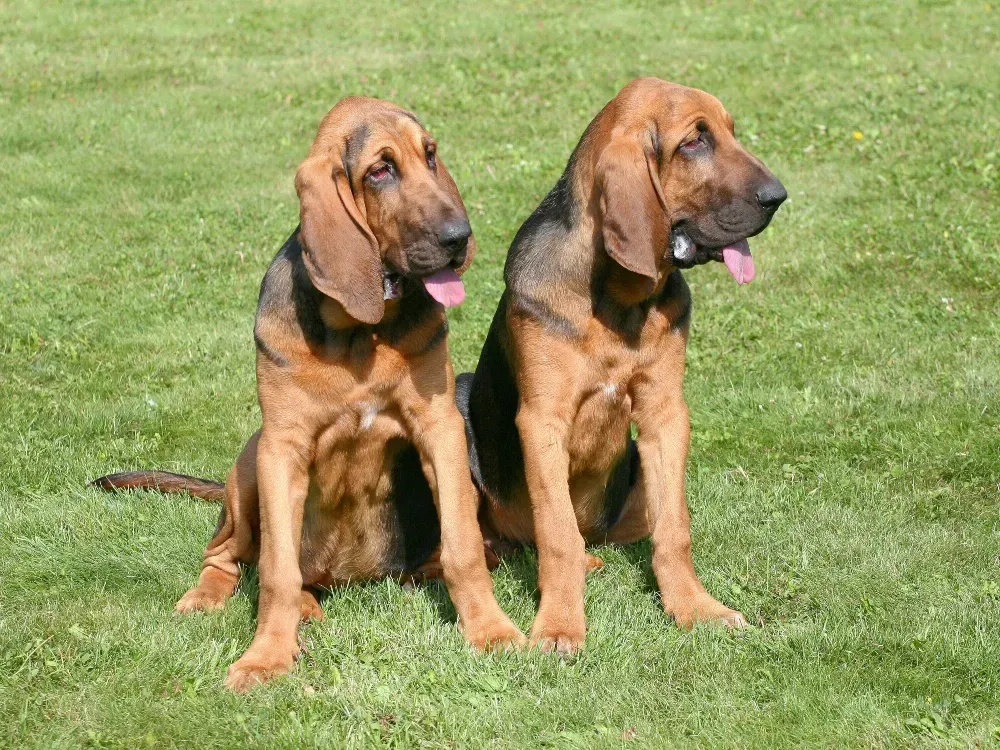Bloodhounds are a breed known for their incredible sense of smell and tracking abilities, a trait that often leads to their employment in search-and-rescue operations. When considering them as family pets, one might wonder how their specialized skills translate to a home environment. As family dogs, bloodhounds are often praised for their patience and affectionate nature, which can make them excellent companions in households with children.

Despite their gentle demeanor with family members, bloodhounds are not a low-maintenance breed. They require ample exercise, mental stimulation, and consistent training to prevent unwanted behaviors such as excessive barking or digging. Their large size and strong build necessitate considerable space, and their coat needs regular grooming to keep it in good condition. However, for families willing to meet these needs, bloodhounds can be highly rewarding pets, known to form strong bonds with their human counterparts.
Bloodhounds do best with owners who understand the breed's necessities and unique characteristics. They thrive on affection from their families, and in return, they offer unwavering loyalty. When properly trained and socialized, bloodhounds can show a remarkable level of gentleness and patience with children, making them a potentially good match for an active family looking for a devoted pet. Their ability to integrate into family life, combined with their distinctive attributes, poses the question of their suitability as family dogs' a question that many bloodhound owners would answer affirmatively.

Bloodhound Breed Overview
The Bloodhound is a breed with a special combination of characteristics, which include a remarkable scent-tracking ability and a distinct temperament. This section provides information on the breed's history, distinguishing traits, and temperament, all of which are important for families considering a Bloodhound as a pet.
History and Popularity
Originally from Europe, the Bloodhound is known for its unrivaled sense of smell and tracking ability. Praised since the Middle Ages for tracking game and humans, this breed has a storied history as a scent hound. Today, they are not only beloved pets but also valuable assets in search and rescue operations. Their popularity continues due to their reputation as efficient working dogs and companionable family pets.
Breed Characteristics
The Bloodhound is a large-sized dog, with males standing between 25-27 inches and females 23-25 inches at the shoulder. A mature Bloodhound can weigh anywhere from 80 to 110 pounds.
| Aspect | Detail |
|---|---|
| Size | Large |
| Coat | Short, dense |
| Colors | Typically black and tan, liver and tan, or red |
| Lifespan | 10-12 years |
They have a dignified appearance, marked by loose, wrinkled skin and long, drooping ears. Despite an often lazy demeanor at rest, they are energetic when on the scent.
Bloodhound Temperament
Bloodhounds are famous for being good-natured and affectionate, making them great companions. They can be stubborn, which requires patience in training, and are highly praised for their intelligence, especially in tracking work. Bloodhounds are known to be gentle with children and other family members, but they need socialization to develop a well-adjusted temperament.
It is important for prospective owners to understand that while they can be noble, they can also exhibit a good-natured laziness mixed with sudden bursts of energy, especially when they catch an interesting scent.
Physical Characteristics and Health
Bloodhounds are distinctive large-breed dogs known for their incredible sense of smell and tracking ability. When considering a Bloodhound as a family pet, understanding their unique physical traits and potential health concerns is crucial for their care and well-being.
Size and Weight
- Size: Bloodhounds are classified as large dogs.
- Weight: Males typically weigh between 90 to 110 pounds, while females are slightly lighter, usually ranging from 80 to 100 pounds.
Coat and Colors
- Coat: They possess a short, dense coat that is fairly easy to maintain.
- Colors: The most common coat colors include:
- Black and Tan: A rich tan base with black across the back and sides.
- Liver and Tan: A warm, deep brown with tan markings.
- Red: A solid, rich red to reddish-tan.
Common Health Problems
Bloodhounds are predisposed to certain health issues that prospective owners should be aware of:
| Health Problem | Description | Consideration for Owners |
|---|---|---|
| Bloat | A life-threatening condition where the stomach expands with gas and can twist. | Should be monitored for signs and receive prompt treatment. |
| Heart Disease | Canine heart diseases, including murmurs and valve problems. | Regular veterinary heart checks are recommended. |
| Elbow Dysplasia | A common joint condition that can lead to lameness or arthritis. | Weight management and appropriate exercise may help prevent exacerbation. |
| Lifespan | On average, Bloodhounds live between 10 to 12 years. | Proper care and regular veterinary check-ups are important to ensure a healthy life. |
Caring for a Bloodhound
Proper care for a Bloodhound includes regular grooming, appropriate nutrition, and adequate exercise to maintain their health and happiness. They are known for their friendly nature, but they require consistent care and attention to their specific needs.
Grooming Needs
Bloodhounds have short hair but are moderate shedders. Regular brushing, at least once a week, is essential to minimize shedding and keep their coat in good condition. They also have a tendency to drool, so owners will need to regularly clean their facial wrinkles to prevent skin infections. Nail trimming and ear cleaning are also critical due to their floppy ears, which can trap moisture and lead to infections.
- Brushing: Once a week
- Drool Cleanup: Daily
- Nails: As needed
- Ears: Weekly check and clean

Feeding and Nutrition
Bloodhounds require a balanced diet of high-quality dog food. Their food should be appropriate for their size, age, and activity level. They can be prone to overeating, so it's important to manage their portions and establish a feeding routine to prevent obesity.
- Puppy (under 1 year): High-quality puppy food, 3-4 meals per day
- Adult: Quality adult dog food, 2 meals per day
- Senior: Consult a vet for special dietary needs
Exercise Requirements
These dogs need regular exercise to maintain their physical health and provide mental stimulation. A Bloodhound's exercise regimen should include daily walks and opportunities to track scents, which can serve as both physical and mental activities for them.
- Walks: Daily, at least 30 minutes
- Other Activities: Scent games, playtime in a secure area
Tracking and scent games are excellent ways to tire them out mentally as well as physically. A fenced yard is ideal for this breed to prevent them from following a scent and possibly wandering off.
Training and Socialization
Training and socialization are crucial components in shaping a Bloodhound into a well-adjusted family member. These dogs are renowned for their tracking abilities, which can be honed through specific training. Early socialization is essential to help them become comfortable with various people and animals.
Behavioral Training
Bloodhounds can exhibit stubbornness, making behavioral training a necessity from a young age. They respond well to positive reinforcement techniques such as:
- Rewards (treats, praise)
- Consistent commands
- Patience during repetition
Training should focus on basic commands like sit, stay, come, and heel to manage their tracking instincts in daily scenarios.
Socializing with People and Pets
Socialization is vital for Bloodhounds to prevent shyness or apprehension around new individuals and pets. They tend to be gentle with children but should be introduced to them early to help establish boundaries. Introducing Bloodhounds to other dogs and cats in controlled environments can foster good manners and prevent chasing behaviors. This can be facilitated through:
| Age | Socialization Focus |
|---|---|
| Puppyhood (2-4 months) | Human interactions, diverse environments |
| 5-12 months | Exposure to other animals, continued human socializing |
Proper socialization leads to a Bloodhound that is confident and well-behaved in a family setting.
Bloodhound Family Compatibility
Bloodhounds are known for their exceptional sense of smell and tracking abilities, yet they are also recognized for their compatibility with families. These dogs are typically friendly and gentle, making them a suitable choice for households with children and other pets. It is important to understand their behavior in family settings and how they interact within the family unit.
Interaction with Children
Bloodhounds have a reputation for being patient and kind, qualities that are beneficial when interacting with children. They often exhibit a tolerant nature, which can be ideal for the rough and tumble of playtime.
- Patience: Bloodhounds tend to be tolerant of children's unpredictable behavior.
- Supervision: Despite their gentleness, supervision is recommended due to their large size.
Living With Other Pets
As dogs that have historically lived and worked in packs, Bloodhounds can coexist peacefully with other pets. Their pack mentality often translates into a companionable nature with other household animals.
- Socialization: Early socialization is crucial to foster a harmonious environment.
- Behavior Management: Encouragement of gentle interactions helps maintain a friendly pet dynamic.
Bloodhound Behavior in the Home
Bloodhounds have specific needs when it comes to their living environment, requiring ample space and secure outdoor areas. Their behaviors can be managed with appropriate house-training and understanding of their natural instincts.
Indoor Space Requirements
Bloodhounds are large dogs that need significant space inside the home. They are not ideally suited to small apartments or confined spaces. Here are key points regarding their indoor space needs:
- Size: They require a spacious indoor environment to move around comfortably without knocking over household items.
- Chewing: These dogs have a tendency to chew on objects, so it's important to provide plenty of chew toys and secure personal belongings.
- House-Training: Bloodhounds can be successfully house-trained, although patience and consistency are crucial due to their independent streak.
Outdoor Considerations
A secure outdoor area is vital for a bloodhound's well-being. Below are key outdoor considerations:
- Fence: A sturdy fence is necessary to prevent escape attempts, as Bloodhounds may follow their nose and wander off.
- Space: An ample yard provides them with the space to explore and exercise.
- Digging: Potential for digging behavior means that gardens and soft ground may be subject to excavation activities.
- Destructive Behavior: Without adequate exercise and stimulation, a Bloodhound may engage in destructive behaviors outdoors. Regular activity helps mitigate this risk.
Common Challenges and Solutions
When welcoming a Bloodhound into a family, owners should prepare for breed-specific challenges such as odor and drooling, as well as their tendency for loud vocalizations. These traits require particular strategies to manage effectively.
Dealing with Odors and Drool
Bloodhounds have a distinct scent that can permeate through the home. Regular grooming is imperative to control odors. They should have:

- Weekly baths: Using a mild, dog-specific shampoo.
- Consistent home cleaning: Regular washing of the dog's bedding, and vacuuming to minimize odor presence.
Drooling is another characteristic. Owners can manage this by:
- Immediate clean-up: Wiping the dog's mouth with a cloth after eating or drinking.
- Preparation: Keeping towels handy in areas the dog frequents to quickly address drool as needed.
Managing Loud Vocalizations
Bloodhounds have a deep, resonant bay that can be loud. They often vocalize when they are on a scent or require attention. To manage their vocalizations:
- Positive reinforcement training: Reward them when they are quiet and gently discourage excessive baying.
- Regular exercise: Ensure they have daily physical activity to reduce boredom and subsequent loud vocalizations.
- Mental stimulation: Providing interactive toys to keep their sensitive nature engaged and lessen the desire to vocalize for attention.
Choosing a Bloodhound
When considering a Bloodhound as a new addition to the family, prospective owners must decide whether to purchase from a breeder or adopt from a rescue. It's essential to consider factors like cost and the dog's history as a sleuth hound or tracker.
Finding a Reputable Breeder
A reputable breeder should prioritize the health and temperament of their Bloodhounds. They should offer:
- Health Clearances: Proof of genetic screenings and veterinary checks.
- Visitation Rights: The opportunity to meet the puppy's parents and see the living conditions.
Prospective owners should expect to pay anywhere from $600 to $1,200 for a well-bred Bloodhound puppy. A detailed contract and records of the puppy's lineage are also signs of a credible breeder. Given their history in law enforcement, a tracker or sleuth hound from a distinguished line may come at a higher cost.
Adopting from a Rescue
For those considering adoption:
- Cost Comparison: Adoption fees typically range from $100 to $300, which often includes vaccinations and spaying/neutering.
- Rescue Groups: Look for rescue groups specializing in Bloodhounds to find a dog experienced in tracking or with a background in a court of law setting.
Adopting from a rescue allows for giving a home to a Bloodhound in need. They often have knowledge regarding the dog's background and any law enforcement training it may have received.
Frequently Asked Questions (FAQs)
This section answers common queries regarding the Bloodhound's compatibility with family life and other pets, their maintenance needs, social behavior, protective instincts, and adaptability to indoor living.

- What character traits make Bloodhounds suitable for families?
- Bloodhounds are known for their gentle and patient nature, making them good companions for families. Their affectionate disposition is well-suited to homes with children.
- How compatible are Bloodhounds with other household pets like cats?
- They can coexist peacefully with cats and other pets, especially if raised with them from a young age. However, supervision is recommended due to their strong hunting instincts.
- What is the maintenance level required for owning a Bloodhound?
- Bloodhounds require regular grooming due to their short coat and tendency to drool. They also need daily exercise to maintain their health and manage their energy levels.
- Can Bloodhounds be considered friendly and sociable with strangers?
Bloodhounds are generally amiable and can be sociable with strangers, though they may exhibit reserved behavior initially. Proper socialization from a young age is crucial to encourage their openness.
- Is the Bloodhound breed known to be protective towards its family members?
- While Bloodhounds are not typically aggressive, they are loyal and may display protective behaviors when their family is threatened.
- Do Bloodhounds adapt well to indoor living environments?
- Bloodhounds can adapt to indoor living if they receive sufficient exercise. They prefer a house with a yard but can live in an apartment setting with the right amount of physical activity.




